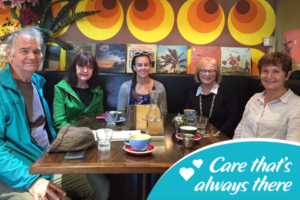An illness doesn’t just impact a patient, it touches everyone they are close to. That is why Mary Potter Hospice offers a companion service for patients who are living in their own home.
Lead by Julie, a team of volunteers spend time with patients and their families to help ease the stress of what they are going through.
“The service is about enriching the patient’s life. Having a companion may mean a patient’s main carer can go out and get some fresh air or runs an errand. For the patient, it means someone different to chat to or spend time with. Some companions and patients go for walks, watch a movie or just sit and chat.”

Julie (right) and Mary Potter Hospice Volunteer Companions, Michael, Mari-Jo, Jo and Annie recently met up for a post-lockdown coffee at a local cafe.The volunteer companions give around 2-4 hours a week. Depending on the patient’s condition, they often will do activities or experiences that they enjoy.
“Companions don’t do anything clinical or practical around the house. They are purely there to give some relief. Sometimes a patient just wants to have a chat about their feelings, politics or the weather.”
Julie says the companions don’t just help the patient. They allow the carer much needed respite knowing that their loved one is being looked after. Often the companion’s focus will turn more to the carer in the later stages of the patient’s illness, Julie says, as they need more support.
During the COVID-19 lockdown, the companion service had to adapt. While volunteers were not able to meet in person, they still kept in touch with their patients and their families.
“My companions were never going to stop talking to their patients. Some have text, some have Facetimed, some have telephoned. They have all done what they can. Some have also helped the with the connection calls the Hospice made during lockdown to patients.”
Julie says she loves her job. Connecting a companion with a patient is “magic”. She says the service brings a lot of joy to both volunteers and families.
“There is nothing like introducing a patient and companion for the first time – it is very, very special. The feedback we get from patients is that they love the time spent with their companion.”
Julie says the companions are a special thread to the overall Hospice care which is provided. The current team of volunteers are a diverse group – with some in their 20s and others in their 80s.
“They all find it really rewarding. Even though the patients are facing significant challenges they love being able to be there for them. It is a very special thing to be able to do.”
